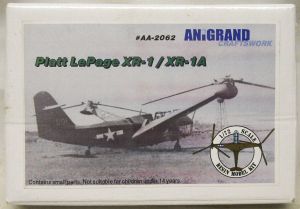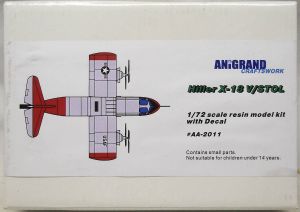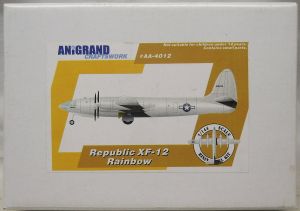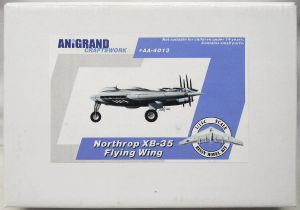Anigrand Model Kits
Anigrand Daimler-Benz Project B, 1/144, AA4001
Resin Model Kit, Box Condition: Exc

$72
Very highly detailed and complete resin kit of this large and ambitious long-range bomber that could attack targets in the USA and in the deepest parts of the USSR. The design was to carry a parasite jet bomber as well as five jet-powered explosive delivery systems. This model includes the P.310256 bomber and your choice of (5) Project F Unmanned aircraft or (5) manned Project E fighters. Never started. The parts are still in the internal factory sealed bags and includes decals and instructions.
Anigrand Curtiss XP-60C / XP-60E, 1/72, AA2064
Resin Model Kit, Box Condition: Exc

$42
Very highly detailed resin kit that is very finely molded. Includes full decals and paint guide. The kit has never been started. The parts are still in the internal factory sealed bags and includes decals and instructions.
Anigrand Platt LePage XR-1 / XR-1A - American WW2 Helicopter, 1/72, AA-2062
Resin Model Kit, Box Condition: Exc

$46
Very highly detailed resin kit that is very finely molded. The kit has never been started. The parts are still in the internal factory sealed bags and includes decals and instructions.
Anigrand North American YF-93A, 1/72, AA2039
Resin Model Kit, Box Condition: NM

$49
Very highly detailed resin kit. It has never been started. The parts are still in the internally sealed factory bags. Includes decals and instructions.
Anigrand Lockheed XP-58 Chain Lightning, 1/72, AA2038
Resin Model Kit, Box Condition: Exc
$54
Starting life as simply an improved P-38, the design requirements changed from single engine pursuit to double seat attacker, then to bomber, and finally as bomber destroyer. This an other issues created a 4 year development, and by then there was no need for a piston-engined bomber destroyer. Top speed was 436 MPH with 2 Allison V-3420-11/13 Turbocharged engine. Very highly detailed resin kit. Still internally sealed. Complete with decals and instructions.
Anigrand Martin XB-51, 1/72, AA2035
Resin Model Kit, Box Condition: Exc

$65
Very highly detailed, high-definition resin cast model kit. Features very fine recessed panel lines, good cockpit, gear wells and more. Never started and all parts but the fuselage halves are still in the internal factory sealed bags and includes decals and instructions. In early 1946, USAAF issued requirement for a new attack bomber to succeed the Douglas A-26 Invader. The Martin Company entered the competition and won; the aircraft was given the designation XA-45. Soon later USAAF revised its requirement for better close-support bombing. Martin accepted the new requirement and received a contract for two prototypes; the project was redesignated XB-51. The first XB-51 made its 1st flight on Oct 1949 and became the fastest ground support bomber at that time. In 1950, with the outbreak of the Korean War, the USAF called for a new night intruder bomber. The XB-51 and English Electric Canberra entered in competition. The XB-51 was faster but the Canberra had much better endurance. After a fly-off in 1951, the Canberra was chosen as the winner. In 1952 the XB-51 project was canceled. Although Martin lost the XB-51 order, they received a license to produce the Canberra under designation B-57.
Anigrand Douglas XB-42 Mix-Master, 1/72, AA2031
Resin Model Kit, Box Condition: VG

$58
Very highly detailed, high-definition resin cast model kit. Features very fine recessed panel lines, good cockpit, gear wells and more. Never started and the parts are still in the internal factory sealed bags and includes decals and instructions. Aircraft History and SpecificationIn 1943, the Douglas began a company funded study to a high speed bomber design which was not liked the traditional wing mounting engines. It was an unusual idea to install the two engines within the fuselage, driving a pair of propellers mounted at the tail. That can leaving the wing and fuselage clean and free of aerodynamics-reducing protrusions. Douglas submitted an unsolicited proposal to USAAF, and was awarded a contract for two prototypes. The first prototype first flew in May 1944. Performance was excellent as described in the original proposal. The second prototype joined the flight test program in August, 1944, and was destroyed in crash in December 1945. By the end of war and the jet-powered bomber soon be forthcoming, the Army Air Force had decided that the XB-42 would not be put into the production. The surviving XB-42 was continued for tests and modification until 1948. But what the XB-42 is really famous for is when Douglas proposed to modify the existing XB-42 airframe, then replaced the piston engines with a pair of turbojets for saving time and cost. This became the XB-43 and the first USA built all-jet bomber to fly.
Anigrand Hiller X-18 V/STOL, 1/72, AA-2011
Resin Model Kit, Box Condition: Exc

$52
Very highly detailed, high-definition cast resin kit of this unique aircraft. The parts are still in the internally sealed bags. Includes decals and instructions. During early 1955, Hiller Aircraft designed a large, tilt-wing VTOL aircraft as an in-house study. In 1956, U.S. Air Force showed interest in this concept and assigned a contract to Hiller for the development of a VTOL cargo transport. The test bed was designated X-18. In order to speed the construction process and to conserve available Air Force funding, the X-18 was built from many existing materials, such as the fuselage from Chase C-122, the turboprop engines from the XFV-1 and XFY-1 and miscellaneous parts from the R3Y. The prototype was completed and started to proceed with ground testing in 1958. A year later, it made first flight without any difficulty. After a total of 20 flights were completed, the Air Force ended its flight-testing and set the X-18 aside for ground tests to develop a database for the upcoming XC-142 transport project. In 1964, the X-18 was disassembled for scrap.
Anigrand Republic XF-12 Rainbow - (XR-12), 1/144, AA-4012
Resin Model Kit, Box Condition: Exc

$70
Very highly detailed 1/144 scale resin kit of this beautiful aircraft. The parts are still in the internally sealed bags. Includes decals and instructions. The Rainbow was not only beautiful but was very fast with a top speed of 460 MPH. Designed as a long range high speed reconnaissance aircraft for the Pacific theater, the design was brilliant and successful. However, the USAAF decided to use modified B-29s (RB-29) instead.
Anigrand North American YF-93A, 1/72, AA2039
Resin Model Kit, Box Condition: Exc

$48
Very highly detailed resin kit. It has never been started. The parts are still in the internally sealed factory bags. Includes decals and instructions.
Anigrand Martin XB-16 Winged Whale, 1/144, AA4016
Resin Model Kit, Box Condition: VG

$78
This is a highly detailed resin model. Never started. The parts are still in the internal factory sealed bags and includes decals and instructions. In 1933, the U.S. Material Division at Wright field began a study for a modern bomber that would able to carry 2500-lb bomb load form 5000 miles and 200mph. This specification was then submitted to the War Department as Project-A and received tentative approval. In 1934, the USAAC began contract negotiations with Boeing and Martin. The specifications called for a long range bomber capable of the destruction by bombs of distant land or naval target, and the ability to reinforce Hawaii, Panama and Alaska without the use of intermediate servicing facilities. Martin submitted Model 145 and was accepted to built a XB-16 prototype. The aircraft was similar in size to the Boeing XB-15, but was to use four Allison liquid-cooled engines instead of air-cooled radial engines that normally used on bombers in the 1930s. In order to increase the range and bomb load, Martin revised the XB-16 design making it much bigger. The wing span was increased to 173 feet and six engines were used, four on the leading edge and two on the trailing edge. The XB-16 was considered as being too large and expensive, and the project was canceled before anything could be built.
Anigrand Northrop XB-35 Flying Wing, 1/144, AA4013
Resin Model Kit, Box Condition: Exc

$74
This is a highly detailed resin model. Never started. The parts are still in the internal factory sealed bags and includes decals and instructions.
Anigrand McDonnell YC-15, 1/72, AA2126
Resin Model Kit, Box Condition: Exc

$145
Well detailed high-definition cast resin model with recessed surface detail. The kit has never been started. The parts that were factory sealed are still in the sealed bags. The large parts that were never factory sealed have been inventoried complete including decals and instructions. In 1972, the U.S. Air Force issued the Advanced STOL transport program for a new medium airlifter that capable of operations into battle zones with short, temporary airfields. Two proposals were accepted for construction as the Boeing YC-14 and McDonnell Douglas YC-15 prototypes. McDonnell Douglas's design incorporated a supercritical wing, the result of NASA research. The design team also chose to use externally double-slotted flaps to direct part of the jet exhaust downwards, while the rest of the exhaust passed through the flap and then followed the downward curve due to the Coanda effect. Two YC-15s were built, the first flight was on 26 August 1975. The second prototype followed in December. The Air Force decided it needed a larger transport that would fly to standard, conventional airfields rather than into battle zones. In 1979, the Air Force formally cancelled the AMST program for both the YC-14 and the YC-15. As a result, the C-X program, the C-17 evolved.
Anigrand Bartini-Beriev VVA-14M1P, 1/144, AA4044
Resin Model Kit, Box Condition: Exc

$64
Sells for $88 new. This is a highly detailed resin model. Never started. The parts are still in the internal factory sealed bags and includes decals and instructions. In late 1950s, the U.S. Navy started the Polaris program which ultimately armed US submarines with ballistic missiles. The USSR quickly issued a requirement for an Anti-Submarine-Warfare system to counter this urgent threat. The Minister of Defense selected Bartini's floatplane design and ordered Beriev OKB to build three prototypes. It was to be developed in three phases. The VVA-14M1 was to be a technology test-bed with inflatable pontoons. The VVA-14M2 was to be more advanced with fly-by-wire flight controls. The third stage would be the VTOL vehicle fully equipped with weapons. In 1972 the first prototype made its first flight. In 1974, the inflatable pontoons were installed but the expansion and retraction caused many problems. They were later replaced by rigid pontoons and the fuselage was lengthened and a pair of 'starting' engines were added. The program continued in 1974 but the engine vibrations caused breakage of the landing gears and rear control flaps. Beriev was given higher-priority work with the A-40 and IL-78, so the program was terminated. Only the one prototype was produced.
Anigrand Yakovlev Yak-24 Horse, 1/72, AA2088
Resin Model Kit, Box Condition: Exc

$52
Highly detailed model with high-definition cast resin parts. Never started. The parts are still in the internal factory sealed bags and includes decals and instructions.
Anigrand Ilyushin Il-102, 1/72, AA-2107
Resin Model Kit, Box Condition: VG

$62
Very highly detailed resin model. Never started. The parts are still in the internal factory sealed bags and includes decals and instructions.
Anigrand Douglas XB-43 Jet-Master -First USA Jet Bomber, 1/72, AA2032
Resin Model Kit, Box Condition: Exc+

$56
Very highly detailed, high-definition resin cast model kit. Features very fine recessed panel lines, good cockpit, gear wells and more. Never started and the parts are still in the internal factory sealed bags and includes decals and instructions. In 1944 the success of the Reich's jet fighter and bomber projects became obvious to all, so the USAAF defined a requirement for the first American jet bomber to be developmented quickly. Douglas proposed to modify the existing XB-42 airframe, then replaced the piston engines with a pair of turbojets to save both time and cost. The contract for two prototypes designated XB-43 was signed and 50 production aircraft were also planned in the same year. Due to early engineering problems, the jet engines were not shipped from GE to Douglas until July 1945. Additionally, the end of war caused a slowdown in development. The first XB-43 finally made its first flight on May 1946. Performance was satisfactory but the USAAF had moved ahead with the new four-engines bombers, the North American B-45 and the Convair XB-46. The 50 aircraft plan was canceled but the test program was still continued until 1951 when the first XB-43 was damaged in an accident. In late 1953 the second prototype was also retired.
